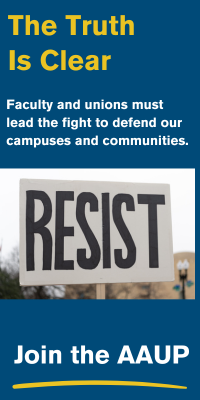- About
- Programs
- Issues
- Academic Freedom
- Political Attacks on Higher Education
- Resources on Collective Bargaining
- Shared Governance
- Campus Protests
- Faculty Compensation
- Racial Justice
- Diversity in Higher Ed
- Financial Crisis
- Privatization and OPMs
- Contingent Faculty Positions
- Tenure
- Workplace Issues
- Gender and Sexuality in Higher Ed
- Targeted Harassment
- Intellectual Property & Copyright
- Civility
- The Family and Medical Leave Act
- Pregnancy in the Academy
- Publications
- Data
- News
- Membership
- Chapters
The Assault on DEI
The Trump administration’s executive order targeting diversity, equity, and inclusion efforts is purposefully vague and designed to inspire fear.
This article is part of a series, "Trump Is Revealing Our Higher Ed Crisis."
On January 21, 2025, President Donald Trump issued Executive Order 14173, “Ending Illegal Discrimination and Restoring Merit-Based Opportunity.” This broad and vague executive order requires all federal agencies and contractors to end what it describes as “illegal discrimination” and encourages private actors to do the same. Yet, despite its extravagant claims, in reality this executive order merely requires compliance with existing law, provides a rhetorical shift in labels of federal action, and threatens future, undefined enforcement.
The sweeping language contained in the order—aimed primarily at “‘diversity, equity, and inclusion’ (DEI) or ‘diversity, equity, inclusion, and accessibility (DEIA)’”—is an attempt to encourage uncritical acceptance of this administration’s characterization of any programs that remedy inequality as “illegal discrimination.” Such “illegal DEI and DEIA policies,” the order claims, “can violate the civil-rights laws of this Nation” and are unfettered sources of harm in “case after tragic case.” Yet the order identifies no specific sources of harm, no illustration of how these policies inherently injure society, and no causal or even corollary link between DEI or DEIA and illegal actions.
Instead, the order only requires actions to comply with existing civil rights laws. Section 4 of the order revokes previous constitutional executive actions that promote diversity or equal opportunity and instructs federal agencies to remove specific terms from their budgets and contracts: “‘diversity,’ ‘equity,’ ‘equitable decision-making,’ ‘equitable deployment of financial and technical assistance,’ ‘advancing equity,’ and [the] like . . . as appropriate.” The remainder of the executive order simply encourages the promotion of vague notions of “individual initiative, excellence, and hard work” and requires a strategic enforcement plan from federal agencies to deter and end “illegal discrimination or preferences” in compliance with Students for Fair Admissions, Inc. v. President and Fellows of Harvard College, through reports to be issued within 120 days. These reports are ordered to include “specific steps or measures to deter DEI programs or principles (whether specifically denominated ‘DEI’ or otherwise),” and each agency is instructed to identify “up to nine potential civil compliance investigations of publicly traded corporations, large non-profit corporations or associations, foundations with assets of 500 million dollars or more, State and local bar and medical associations, and institutions of higher education with endowments over 1 billion dollars.”
Section 7 of the order, however, provides three exemptions to the order’s scope: in “lawful Federal or private sector employment and contracting preferences for veterans of the U.S. armed forces,” in First Amendment–protected speech, and in teaching that occurs at a federally funded institution of higher education “as part of a larger course of academic instruction.”
The limited scope and narrow set of actions compelled by the order make clear that its grandiose rhetoric is designed to promote unnecessary compliance with the false assumption that all uses of diversity in law and policy are illegal. The invocation of the Supreme Court’s 2023 affirmative action ruling, for instance, attempts to imbue the claims in the order with a veneer of legality, even though the court’s opinion concerns only the formal use of race in admissions as a means to achieve racial diversity in higher education. There, the Supreme Court found that admissions processes at Harvard and the University of North Carolina violated the “narrow restrictions” permitted by previous decisions: “University programs must comply with strict scrutiny, they may never use race as a stereotype or negative, and—at some point—they must end.” However significant the barriers the court has constructed to the use of race in admissions may be, its 2023 ruling in no way supports the assumptions underlying the executive order: that any use of diversity, equity, or inclusion is inherently race-based discrimination and that racial diversity is not a compelling governmental interest.
From the Students for Fair Admissions cases back to Grutter v. Bollinger (2003) and Regents of the University of California v. Bakke (1978), the Supreme Court has consistently upheld the educational and social benefits that flow from a “diverse student body” as a compelling state interest that may survive even strict scrutiny. In Grutter, the court traced the importance of racial diversity back to Brown v. Board of Education (1954)—which held that “education . . . is the very foundation of good citizenship”—and explained that “for this reason, the diffusion of knowledge and opportunity through public institutions of higher education must be accessible to all individuals regardless of race or ethnicity.” Any illegality in actions related to diversity, equity, or inclusion would therefore arise from the means undertaken in achieving this compelling goal—not from pursuing the goal itself. The order, however, fails to identify any particular means or programs that may be the cause of illegality, other than the use of words like diversity, equity, or inclusion.
The lack of guidance or standards within the executive order was central to the preliminary injunction issued by the US District Court for the District of Maryland on February 21, 2025. In National Association of Diversity Officers in Higher Education v. Trump, a case in which the AAUP was a plaintiff, the district court issued a preliminary injunction based on the contractual terms of the order and the “enforcement threat provision” contained in section 4. The court found that the plaintiffs were likely to succeed on their claims that these two terms of the order violated the First Amendment in clearly enacting content- and viewpoint-based discrimination “based on the face of the . . . Order, and hammered home by the egregiously content-based actions taken by various agencies pursuant to the . . . Order.” By failing to provide any guidance or notice to parties who are potentially subject to regulation under the executive order, the order simply creates a blank check for pretextual enforcement of anti-DEI polices against any major organization or institution that the Trump administration finds distasteful.
In sum, “Ending Illegal Discrimination and Restoring Merit-Based Opportunity” is a purposefully vague and thinly veiled threat. The order lacks any substantive or meaningful standards that could be used to understand, gauge, or measure what actions or policies might actually be illegal and, in place of defined guidance, relies on the ominous threat of enforcement through a looming report, forthcoming “specific steps,” and potential investigations—the purpose of which is to develop a culture of fear and obedience through intimidation rather than actual lawmaking, enforcement, or clear executive decision-making.
Instead of giving in to terror through anticipatory compliance and by removing programs designed to remedy social inequalities, institutions of higher education should recognize that existing programs to foster racial diversity, equity, and inclusion have been designed and are functioning in compliance with existing civil rights laws. They are therefore easily defensible against the vague, ill-defined scope of the executive action, which, as of this writing, cannot be enforced because of the preliminary injunction issued by the district court.
Instead, colleges and universities should devote their time and resources to supporting programs and organizations that stress the importance of racial diversity and recognize the necessity of facilitating equity, given the country’s history of oppression and discrimination.
Jeremiah Chin is assistant professor of law at the University of Washington School of Law. His teaching and research focus on constitutional law, race, Indigeneity, and children’s rights.





